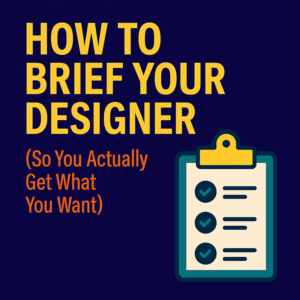Designers aren’t mind readers (though we do have a sixth sense for bad kerning). If you want a logo that hits the mark, you need a brief that’s more than “make it pop.” A good design brief is like a satnav for creativity—it sets the destination, outlines the route, and avoids the scenic detours that cost time and budget.
Here’s how to write a brief that gets results—and earns you a designer who doesn’t ghost you halfway through the project.
1. Start With the Big Picture
Begin with a short overview of your business: what you do, who you serve, and what makes you different. This gives your designer context—and context is everything.
Bonus points: Include your mission, values, and a one-liner that sums up your brand vibe (e.g. “We’re like the Spotify of dog grooming”).
2. Define the Project Goals
What are you trying to achieve? A logo refresh? A full rebrand? A new identity for a product launch? Be specific. The clearer your goals, the better your designer can align their thinking.
Tip: Avoid vague phrases like “make it modern.” Instead, say what you want people to feel or do when they see the design.
3. Know Your Audience
Who are you talking to? Describe your ideal customer like you’re setting them up on a blind date. Age, profession, lifestyle, values—anything that helps your designer visualise who they’re designing for.
Pro move: Include what your audience isn’t too. It helps avoid designs that miss the mark.
4. Share Your Brand Personality
Are you bold and rebellious? Calm and trustworthy? Quirky and clever? Your brand’s personality should guide the tone of the design. If you’ve got existing brand guidelines, share them. If not, describe your vibe in three words.
5. List the Deliverables
Be clear about what you need. Just a logo? Or a full suite: logo variations, social media assets, brand guidelines, business cards, etc.? The more specific you are, the smoother the process.
6. Set the Timeline and Budget
Designers love clarity. Be upfront about your timeline and budget. It helps them plan, prioritise, and propose solutions that fit your scope.
7. Include Visual References (But Don’t Dictate)
Share examples of logos or styles you like—and explain why. Is it the colour? The simplicity? The typography? This helps your designer understand your taste without copying someone else’s work.

